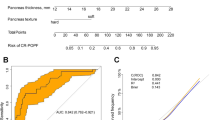Abstract
Background
There lacks an ideal model for accurately predicting clinically relevant postoperative pancreatic fistula (CR-POPF) after pancreatoduodenectomy (PD). This study aimed at developing a nomogram with high accuracy in predicting CR-POPF after PD.
Methods
A total of 1182 patients undergoing PD in the First Affiliated Hospital of Sun Yat-sen University (FAHSYSU, n = 762) and Fudan University Shanghai Cancer Center (FUSCC, n = 420) between January 2010 and May 2018 were enrolled. The patients from FAHSYSU were assigned as testing cohort, and those from FUSCC were used as external validation cohort. Univariate and multivariate logistic regression analyses were performed to determine the predictive factors for CR-POPF. Nomogram was developed on the basis of significant predictors. The performance of nomogram was evaluated by area under receiver operating characteristic (ROC) curve (AUC), calibration curve, and decision curve analysis.
Results
In testing cohort, 87 out of 762 patients developed CR-POPF. Three predictors were significantly associated with CR-POPF, including body mass index ≥24.0 kg/m2, pancreatic duct diameter <3 mm, and drainage fluid amylase on postoperative day 1 ≥2484 units/L (all p ≤ 0.001). Prediction of nomogram was accurate with AUC of 0.934 (95% confidence interval [CI]: 0.914–0.950) in testing cohort and 0.744 (95% CI: 0.699–0.785) in external validation cohort. The predictive accuracy of nomogram was better than that of previously proposed fistula risk scores both in testing and external validation cohort (all p < 0.05).
Conclusions
The novel nomogram based on three easily available parameters could accurately predict CR-POPF after PD. It would have high clinical value due to its accuracy and convenience.




Similar content being viewed by others
References
Kastenberg ZJ, Morton JM, Visser BC et al (2013) Hospital readmission after a pancreaticoduodenectomy: an emerging quality metric? HPB Off J Int Hepato Pancreato Biliary Assoc 15:142–148
Vollmer CM Jr, Sanchez N, Gondek S et al (2012) A root-cause analysis of mortality following major pancreatectomy. J Gastrointest Surg Off J Soc Surg Aliment Tract 16:89–102 Discussion 102–103
Ahmad SA, Edwards MJ, Sutton JM et al (2012) Factors influencing readmission after pancreaticoduodenectomy: a multi-institutional study of 1302 patients. Ann Surg 256:529–537
Denbo JW, Orr WS, Zarzaur BL et al (2012) Toward defining grade C pancreatic fistula following pancreaticoduodenectomy: incidence, risk factors, management and outcome. HPB Off J Int Hepato Pancreato Biliary Assoc 14:589–593
Lowy AM, Lee JE, Pisters PW et al (1997) Prospective, randomized trial of octreotide to prevent pancreatic fistula after pancreaticoduodenectomy for malignant disease. Ann Surg 226:632–641
Bassi C, Marchegiani G, Dervenis C et al (2017) The 2016 update of the international study group (ISGPS) definition and grading of postoperative pancreatic fistula: 11 years after. Surgery 161:584–591
Ansorge C, Nordin JZ, Lundell L et al (2014) Diagnostic value of abdominal drainage in individual risk assessment of pancreatic fistula following pancreaticoduodenectomy. Br J Surg 101:100–108
Giglio MC, Spalding DR, Giakoustidis A et al (2016) Meta-analysis of drain amylase content on postoperative day 1 as a predictor of pancreatic fistula following pancreatic resection. Br J Surg 103:328–336
Callery MP, Pratt WB, Kent TS et al (2013) A prospectively validated clinical risk score accurately predicts pancreatic fistula after pancreatoduodenectomy. J Am Coll Surg 216:1–14
Mungroop TH, van Rijssen LB, van Klaveren D et al (2019) Alternative Fistula Risk Score for Pancreatoduodenectomy (a-FRS): design and international external validation. Ann Surg 269:937–943
Harrell FE Jr, Lee KL, Mark DB (1996) Multivariable prognostic models: issues in developing models, evaluating assumptions and adequacy, and measuring and reducing errors. Stat Med 15:361–387
DeLong ER, DeLong DM, Clarke-Pearson DL (1988) Comparing the areas under two or more correlated receiver operating characteristic curves: a nonparametric approach. Biometrics 44:837–845
Vickers AJ, Elkin EB (2006) Decision curve analysis: a novel method for evaluating prediction models. Med Decis Mak Int J Soc Med Decis Mak 26:565–574
Vickers AJ, Cronin AM, Elkin EB et al (2008) Extensions to decision curve analysis, a novel method for evaluating diagnostic tests, prediction models and molecular markers. BMC Med Inf Decis Mak 8:53
Gaujoux S, Cortes A, Couvelard A et al (2010) Fatty pancreas and increased body mass index are risk factors of pancreatic fistula after pancreaticoduodenectomy. Surgery 148:15–23
Chen JY, Feng J, Wang XQ et al (2015) Risk scoring system and predictor for clinically relevant pancreatic fistula after pancreaticoduodenectomy. World J Gastroenterol 21:5926–5933
Roberts KJ, Hodson J, Mehrzad H et al (2014) A preoperative predictive score of pancreatic fistula following pancreatoduodenectomy. HPB Off J Int Hepato Pancreato Biliary Assoc 16:620–628
Kim JY, Park JS, Kim JK et al (2013) A model for predicting pancreatic leakage after pancreaticoduodenectomy based on the international study group of pancreatic surgery classification. Korean J Hepato-Biliary-Pancreatic Surg 17:166–170
Wellner UF, Kayser G, Lapshyn H et al (2010) A simple scoring system based on clinical factors related to pancreatic texture predicts postoperative pancreatic fistula preoperatively. HPB Off J Int Hepato Pancreato Biliary Assoc 12:696–702
Author information
Authors and Affiliations
Corresponding authors
Ethics declarations
Conflict of interest
The authors declare that they have no conflict of interest.
Additional information
Publisher's Note
Springer Nature remains neutral with regard to jurisdictional claims in published maps and institutional affiliations.
Electronic supplementary material
Below is the link to the electronic supplementary material.
Rights and permissions
About this article
Cite this article
Huang, XT., Huang, CS., Liu, C. et al. Development and Validation of a New Nomogram for Predicting Clinically Relevant Postoperative Pancreatic Fistula After Pancreatoduodenectomy. World J Surg 45, 261–269 (2021). https://doi.org/10.1007/s00268-020-05773-y
Accepted:
Published:
Issue Date:
DOI: https://doi.org/10.1007/s00268-020-05773-y




